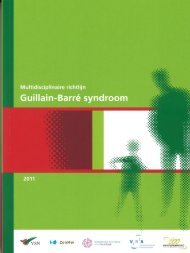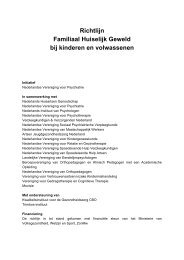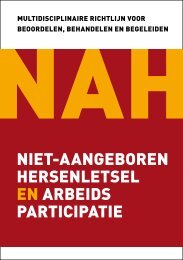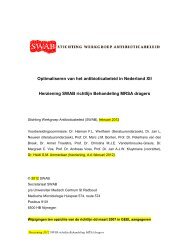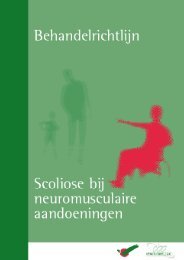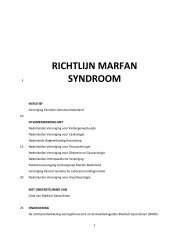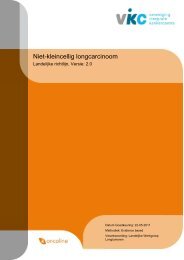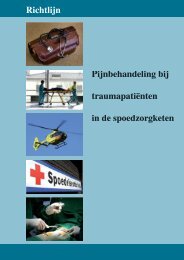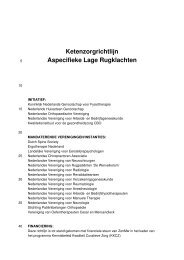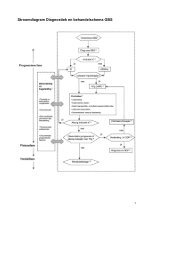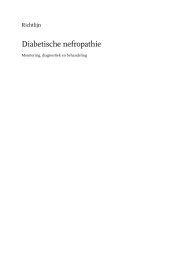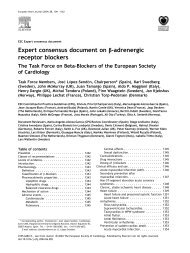Richtlijn: Otitis Externa - Kwaliteitskoepel
Richtlijn: Otitis Externa - Kwaliteitskoepel
Richtlijn: Otitis Externa - Kwaliteitskoepel
Create successful ePaper yourself
Turn your PDF publications into a flip-book with our unique Google optimized e-Paper software.
Pijnbehandeling<br />
Uitgangsvraag 2<br />
Wat is de optimale pijnbehandeling van patiënten met een acute otitis externa?<br />
Onderbouwing<br />
Pain relief is a major goal in the management of AOE. Frequent use of analgesics is often necessary to<br />
permit patients to achieve comfort, rest, and to resume normal activities (Schechter 1993, Joint<br />
Commission on Accreditation of Health Care Organizations 2001, American Academy of Pediatrics<br />
2001). Ongoing assessment of the severity of discomfort is essential for proper management. Use of<br />
a faces (Bieri 1990), Oucher (Beyer 1998), or visual analog (Powell 2001) scale may help determine<br />
the level of pain, particularly for children and non-English speaking patients.<br />
Systemic<br />
Adequate pain control requires knowing the dose, timing, routes of delivery, and possible adverse<br />
effects of an analgesic (Schechter 1993, Joint Commission on Accreditation of Health Care<br />
Organizations 2001, American Academy of Pediatrics 2001, Loesser 2001). Mild to moderate pain<br />
usually responds to paracetamol or nonsteroidal anti-inflammatory drugs (NSAID’s) given alone or in<br />
fixed combination with an opioid. Administering a nonsteroidal anti-inflammatory drug during the<br />
acute phase of diffuse AOE significantly reduces pain compared with placebo (Valencia 1987).<br />
Topical<br />
There are no clinical trials that show efficacy on pain relief of topical opioids in AOE, and the use of<br />
these drops may mask progression of underlying disease while pain is being suppressed. Topical<br />
benzocaine may cause contact dermatitis that can worsen or prolong AOE (Lucente 1995). If a topical<br />
anesthetic drop is prescribed for temporary pain relief, the patient should be reexamined within 48<br />
hours to ensure that AOE has responded appropriately to primary therapy. The addition of a topical<br />
steroid to topical antimicrobial drops has been shown to hasten pain relief in some randomized trials<br />
(Pistorius 1999, van Balen 1993, Roland 2007), but others have shown no significant benefits (Slack<br />
1987, Pfifidis 2005, Schwartz 2006).<br />
Nonpharmacologic therapies such as heat or cold, relaxation, and distraction are unproven.<br />
Conclusies<br />
Level of evidence 2<br />
Valencia 1987<br />
Level of evidence 4<br />
Expert opinion<br />
Level 1<br />
Pistorius 1999, van Balen<br />
1993, Roland 2007 Slack 1987,<br />
Pfifidis 2005, Schwartz 2006<br />
Mild to moderate pain usually responds to paracetamol or<br />
nonsteroidal anti-inflammatory drugs (NSAID’s).<br />
It is plausible that paracetamol and NSAID’s relieve pain caused by<br />
otitis externa.<br />
There is conflicting evidence regarding the effects of the addition<br />
of a topical steroid to topical antimicrobial drops on pain relief.<br />
18 <strong>Richtlijn</strong> <strong>Otitis</strong> <strong>Externa</strong> 2010<br />
Nederlandse Vereniging voor Keel-Neus-Oorheelkunde en Heelkunde van het Hoofd-Halsgebied




